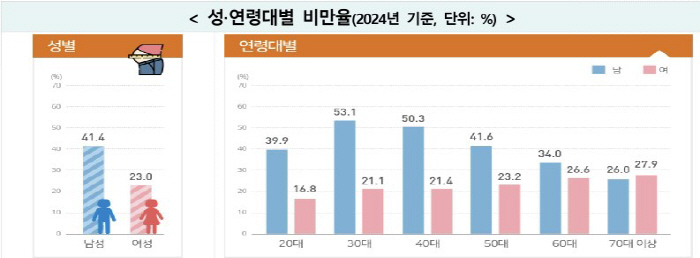Korea's Adults 34.4% Obesity...More than 30% increase in 10 years
Nov 10, 2025
|
According to the Centers for Disease Control and Prevention's '2024 Community Health Survey', 34.4% of adults were obese in 2024. Compared to 26.3% 10 years ago, the self-reported obesity rate increased by about 30.8%.
Men's obesity rate was 41.4 percent and women's 23.0 percent, which was about 1.8 times higher in men than women. Men in their 30s (53.1%) and 40s (50.3%) who are active in social life have high obesity rates, and about 1 in 2 people are obese, while women in their 60s (26.6%) and 70s (27.9%) have relatively high obesity rates.
In addition, about one in two (54.9%) of the total adult population in Korea answered that they were subjectively obese. Among obese people, 77.8% of men and 89.8% of women perceived themselves as obese, and 13.0% of men and 28.2% of non-obese people perceived themselves as obese, indicating that women have more differences between their actual body type and perception than men.
In addition, about three out of five (65%) of the total adult population in Korea tried to lose or maintain weight. As a result of analyzing the weight control attempt rate, 74.7% of men and 78.4% of women were obese, and 42.0% of men and 64.6% of women were non-obese, showing a high rate of weight control attempts in non-obese groups, especially women about 1.5 times higher than men. In both groups, the rate of attempted weight control tended to decrease as the elderly increased.
By region, cities and provinces with the highest obesity rates were Jeonnam (36.8%) and Jeju (36.8%), while the lowest cities and provinces were Sejong (29.1%).
It has been confirmed that obesity rates have increased in all 17 metropolitan cities and provinces nationwide over the past decade. Jeonnam showed the largest increase, up 11.4%p (25.4% in 2015 → 36.8% in 2024), followed by Ulsan and Chungnam. On the other hand, Sejong showed the most moderate increase, with only a 2.9% increase (26.2% in 2015 → 29.1% in 2024), while Daejeon and Gangwon also recorded relatively low increases.
Meanwhile, according to OECD health statistics, Korea (36.5%) remains lower than the OECD average (56.4%), but it is necessary to continuously monitor and strengthen customized health care policies as lifestyle changes and Westernized diets continue to increase.
Lim Seung-kwan, head of the Korea Centers for Disease Control and Prevention, said "With the recent active use of obesity drugs, public interest in weight control and diet is increasing. Obesity is a leading disease of various chronic diseases, and it was intended to provide accurate and reliable statistics on obesity-related perceptions. The Korea Centers for Disease Control and Prevention plans to continue to strengthen the production of evidence for prevention and management of chronic diseases through community health surveys and national health nutrition surveys as well as obesity to promote the health of the people, while conducting training on chronic disease specialists (FMTP) to conduct evidence-based health projects in front-line health centers, and continue to discover and spread best local health cases.
This article was translated by Naver AI translator.














